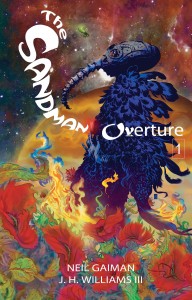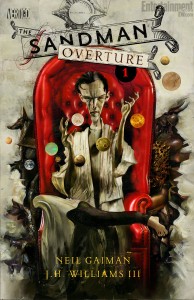The Sandman: Overture 1
Reviewed by Tony Keen 23-Jan-14
Can Sandman: Overture overcome the weight of expectation?
 I recall science fiction scholar Gary Wolfe talking once about how there is a coterie of Neil Gaiman fans who simply want Gaiman to write more Sandman for the rest of his life. On one level, this seems a strange thing to want, as readers are still getting the same sort of material anyway; a great deal of Gaiman’s later work, from Neverwhere through American Gods to “The Doctor’s Wife”, operates in territory he mapped out in Sandman. Not that there’s anything wrong with that – Gaiman found his mode and naturally stuck with it, and besides, the territory mapped out in Sandman is very large. And some of what he has produced, for example Stardust in all its incarnations, have been things of beauty.
I recall science fiction scholar Gary Wolfe talking once about how there is a coterie of Neil Gaiman fans who simply want Gaiman to write more Sandman for the rest of his life. On one level, this seems a strange thing to want, as readers are still getting the same sort of material anyway; a great deal of Gaiman’s later work, from Neverwhere through American Gods to “The Doctor’s Wife”, operates in territory he mapped out in Sandman. Not that there’s anything wrong with that – Gaiman found his mode and naturally stuck with it, and besides, the territory mapped out in Sandman is very large. And some of what he has produced, for example Stardust in all its incarnations, have been things of beauty.
Nevertheless, there is always going to be a desire held by some to see Gaiman return to the brand that made his name (just as fans forced Arthur Conan Doyle to return to Sherlock Holmes, so this is hardly a new phenomenon). Since the regular series ended in 1996, Gaiman has made two major returns to Sandman, the 1999 illustrated novel The Dream Hunters, and 2003’s collection of stories, Endless Nights, plus a couple of short stories featuring Death (I’m not counting P. Craig Russell’s version of The Dream Hunters, as Gaiman’s involvement in the adaptation was minimal). And now here comes Overture, the story of the adventure that left Dream so tired that he could be caught by Roderick Burgess, the situation that began Sandman 1 back in 1989.
Obviously, Gaiman’s return to Sandman will create a great sense of expectation. Does Overture deliver?
The art, by J.H. Williams III, is nice. It’s not perhaps as striking as his work for Promethea. But it’s perfectly fine, well-drawn material that doesn’t detract from the story, is easy enough to follow, and has a few clever and effective tricks to display.
 But the artwork was never really the point with Sandman, and though some artists (e.g. P. Craig Russell, Bryan Talbot, Michael Zulli) delivered excellent work, sometimes Sandman was stuck with poor drawing. What kept the readers coming back was Gaiman’s scripts and stories, which always overcame any failings in the art. Are they still as strong?
But the artwork was never really the point with Sandman, and though some artists (e.g. P. Craig Russell, Bryan Talbot, Michael Zulli) delivered excellent work, sometimes Sandman was stuck with poor drawing. What kept the readers coming back was Gaiman’s scripts and stories, which always overcame any failings in the art. Are they still as strong?
The first thing to note is that Overture is clearly written by Gaiman the novelist, rather than Gaiman the 1990s comics writer. Narrative captions are longer, and a touch more purple, than we’ve been used to in Gaiman’s comics. The sparseness of the comics scriptwriter has, in some places, been driven out by the expansiveness of the novelist.
This may also explain why in this “extra-sized issue” (actually only 28 pages, of which four are taken up with a single fold out spread) there seems to be rather less story than used to be found in a regular 22-page issue of Sandman. The pace is further slowed by seven pages involving the Corinthian, that tell the reader nothing that they would not already be aware of if they were Sandman regulars (the Corinthian murders young boys and eats their eyes – yes, we know). Of course, the apparent role of this scene may have to be re-evaluated in the light of subsequent issues, but at the moment this looks like a set-up for “The Doll’s House”, and I wonder if there will be other set-ups for Sandman stories throughout Overture.
The trouble is, though these stories are in the future at this point in terms of the internal chronology of Sandman, they are in the past as far as the reader is concerned, and they don’t need setting up. All the appearance of the Corinthian achieves here is provide further reassurance to the reader that they are reading Sandman, by parading familiar characters who have no actual role in the story. (Will we see Robert Galdling again?) This sort of fan service is all very well, and often can have its place, but here it seems to be getting in the way of the story.
The result is that by the end of issue 1 of Overture the reader still doesn’t have much idea of the story. But what they do know (and here I am afraid I’m going to spoil you for the end of the issue) is that Gaiman is addressing one of the issues that he’s always previously avoided.
In the Slings and Arrows Comic Guide, a volume every serious comics fan should own,* Fiona Clements criticises Gaiman’s writing of Sandman for (among other things) not drawing proper distinctions between different meanings of the English term “dream”, and how Dream of the Endless was related to them. But I always felt that one of the deliberate features of Sandman was that certain questions about how the Endless actually worked were never fully explained. How, for instance, can there be anything that isn’t in Destiny’s book? It’s never explained, but Delirium tells us that such things exist. Essentially, such fantasy edifices as Sandman are kept up by people not worrying too much about how they work – as soon as anyone starts examining the nuts and bolts, the whole thing falls down. Gaiman’s object as a writer should be to divert the readers’ attention from such issues.
In Overture, he highlights one instead. An issue that often lurks at the back of the mind when reading Sandman is whether Dream and the Endless are simply tied to Earth, or whether they are there for the whole of the universe. Most of the time, it appears to be the former, but every so often there are moments that suggest the latter. The latter seems more logical, but then one has to ask why the Endless all seem so obsessed with humanity. In general, this is a question best left aside, but Overture targets it, and reveals different aspects of Dream from across the universe.
I can’t help feeling this is a “bowl of petunias” moment. In the first radio series of The Hitch-Hiker’s Guide to the Galaxy, Douglas Adams wrote about a bowl of petunias called into existence over a planet, and the only thing it thought as it fell was “Oh no, not again”. No explanation is given, and the joke works better because of this. But in the third novel, Adams, presumably bored of endless questions about the bowl of petunias, explained it all. The result diminished the original moment. Similarly, I feel here Gaiman is trying to explain something about the world of the Endless that just shouldn’t be explained.
However, this is probably not the biggest problem with Overture. That, I would argue, is simply that the comic is merely okay. It’s a perfectly well-written, if slow, comic. But it’s not particularly wonderful, and that is perhaps what many will expect. One of the things that made Sandman so successful was that no-one had quite seen anything like it before – a mythological fantasy series capable of accommodating a wide range of characters and themes, ostensibly tied in to the DC Universe, but actually operating for the most part in its own little sealed-off pocket. The issue with Overture is that it’s nothing more than just another Sandman comic.
* I particularly recommend those entries credited to “HS”.
Tags: JH Williams III, Neil Gaiman, Sandman, Vertigo
Yeah, I always got the impression in the original Sandman that the Endless were all over the place. I’m pretty sure that at least one of them actually mentions that they’re in several places at once.
So I read this and thought “What, so Morpheus is just the local franchise holder?”
Maybe it’ll make more sense in the end (did the second volume come out yet? Maybe I’ll wait for a collected edition) but this did have a “you can’t go back” feel to it.
Second issue is delayed until next month (ish).
We know that Dream hangs out with stars, because he does so in Endless Nights.
And there’s a scene in Brief Lives that’s set on Krypton, if I remember correctly.
I wasn’t expecting there to be _different_ ones in each place though. I expected him to just be in all of those places at once. We’ll see what he does with that though.
Tony, you’re the first person I’ve ever seen who has agreed on the calamity of Douglas Adama explaining the ‘bowl of petunias’ joke.
Your criticisms are valid, but this is only the first issue. We can wait until it’s all done before coming to final conclusions, surely? Though, having said that, the absolute bollock dropped by not having issue 2 – on a bi-monthly schedule – be ready anywhere remotely near time, on a prestige series that’s had as big a lead-time as this has, is ridiculous.
I already feel about ‘Sandman Overture’ as I do about the long ago Foglio and Freff ‘D’Arc Tangent’: a classy one-off of complete irrelevance.
Funny, no-one has ever disagreed with me about the petunias …
Yes, I agree, final analysis must wait until the series is completed. But some analysis is warranted now, and I can only judge on what we have seen.